Path of Exile is a 100% free-to-play ARPG with no pay-to-win elements, and can be compared to Diablo 2 in many different ways. Today, a reliable Path of Exile currency trading website, MmoGah, shares with you some help information for players who are new to the game. Please click UglyStru’s video for more details on everything you need to start playing Path of Exile, and all the content of this article is quoted from his video:
Get a Loot Filter
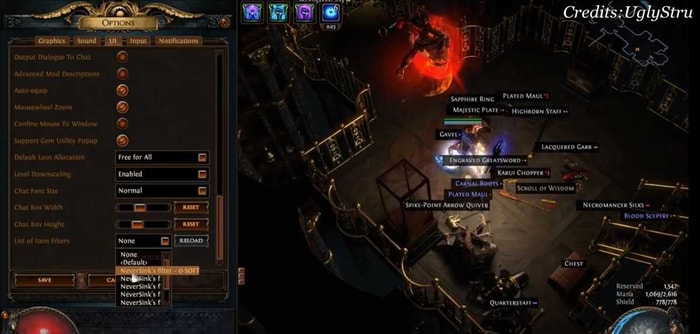
Before you start playing, you should get a loot filter. Because there are so many items that drop as you kill things, you need a filter to hide all of the garbage items that you should not even bother with and to highlight more rare and helpful items. I’d recommend starting with NeverSink’s loot filter. All you need to do is paste these files into your Documents - My Games - Path of Exile, and then select it in the UI tab. I recommend starting with the soft or regular filter, for now, then just moving up to the Semi strict filter as you progress.
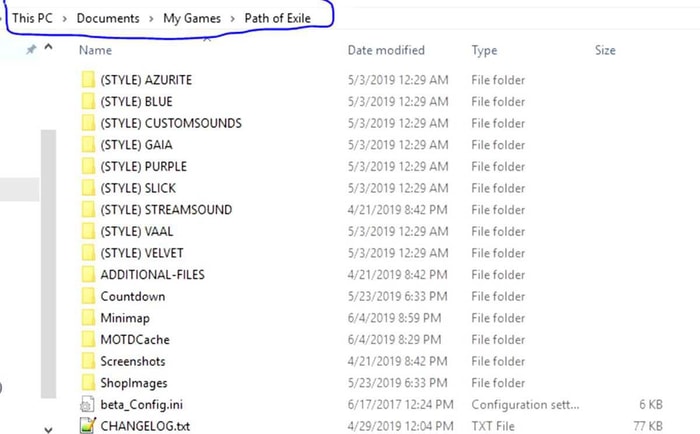
Classes & Attributes
Next, we will talk about the starting classes and attributes. The three main attributes are Strength, Dexterity, and Intelligence.
Strength increases your maximum health and melee damage.
Dexterity increases your Accuracy and your Evasion rating which will give you a chance to evade incoming attacks.
Intelligence increases your mana and energy shield, and energy shield is just a secondary health pool for less tanky characters.
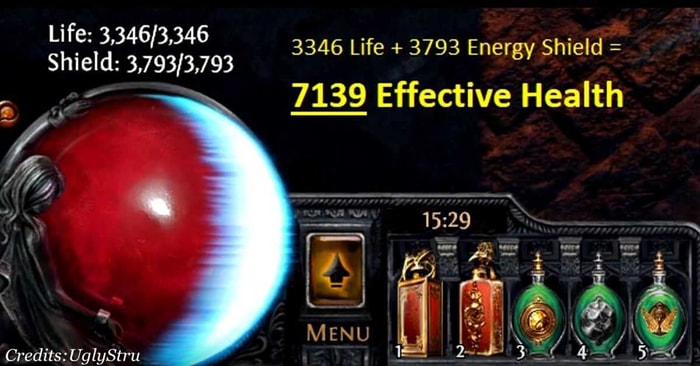
In path of exile, you have 6 classes to start from with a seventh unlocked during your first playthrough. Each of the classes starts somewhere else in the skill tree, three of these classes specialize in one specific attribute while the other three are hybrid classes. The seventh character - Scion is the most universal and can specialize in any of the three attributes. There are 3 archetypes to choose from each class, but you won’t unlock these until at least Act 3.
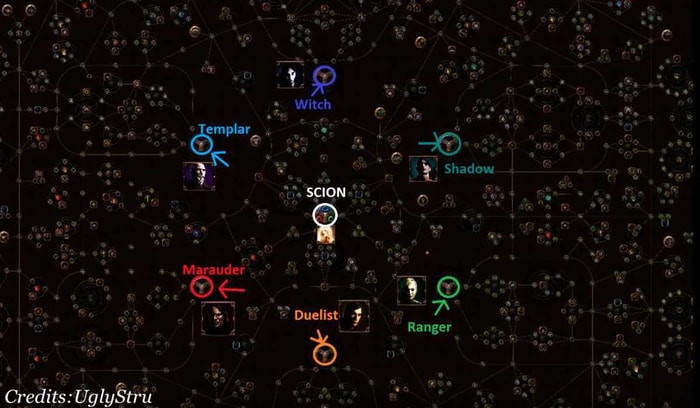
Skill Tree
Speaking of the Skill Tree, it can be very overwhelming to new players. However, you don’t need to really memorize any of it. In fact, your character only gets about 120 points to allocate by max level.
Which class you choose will determine your starting point on the skill tree. The beauty of Path of Exile is that you can start as any character and travel to any passive node you’d like. However, for example, if you want a melee character, it will be more efficient to start as a Duelist rather than a Witch since the nodes are closer to his starting point for things like axes and swords, etc. Also, whatever you spec into on the tree is not permanent. You will get a handful of refund points to spec out points during the leveling process, or you can use a currency item called an Orb of Regret which can be dropped by monsters. Overall, I’d recommend scoping out the skill tree a little bit and just planning a path to certain nodes you’d like to take as you go before really getting started.
As you travel around the skill tree, you may see these empty sockets called jewel sockets. Jewels are alternative to the static passive nodes on the tree. You may find these jewels dropping from monsters or as quest rewards. Once you obtain a jewel and allocate the point in the tree, you can socket the jewel into the slot.
Active Skills
With passive skills out of the way, we will now touch on active skills. In Path of Exiles, skills are not learned as you level, instead, they are linked with gems that you socket it into your gear. Aside from accessories, your gear will contain colored sockets that can hold gems respective to their color. Once you socket a gem, you can bind the skill to your Hotbar below.
Skill gems gain XP as they are equipped and level up just like characters do up to level 20. The higher their level, the more effective they become.
Also, cooldowns do not exist on most abilities. Instead, they rely on your mana pool to be cast. One thing to know is that skill gems do have level requirements and attribute requirements. So, take note of these when using and leveling your gems.
One mistake people often make is that they socket a plethora of skills and fill their hotbar very early. This is not really something you’ll want to do. Most characters have about three main skills that they focus on. A single target skill for killing bosses, an AoE skill for clearing mobs, and a movement skill to help you clear areas quicker and escape from danger. The other sockets in your gear are normally reserved for supporting gems, and slots in your hotbar are usually used for auras and curses.
Auras & Curses
Auras are persistent buffs that reduce your maximum mana pool but will remain active indefinitely. These are stable in most builds and can double, even triple your damage output. So, don’t forget about these.
Curses are temporary debuffs that can be inflicted on enemies. By default, curses are cast and only last for a few seconds. However, you can turn them into an aura with another skill gem or link them with other skills to inflict the curse using other methods.
Linking Support Gems
Skills can be modified and buffed by linking sockets on your gear and socketing support gems. When sockets are linked, each of the gems that are in those linked sockets will affect each other. For example, if I am specializing in a skill called Cyclone, I can link support gems to other sockets to modify my Cyclone skill. Here I can link melee physical damage which will buff the physical damage it does, and I will also add added fire damage to give some extra fire damage.
Sockets
One-handed weapons have up to 3 sockets. Boots, gloves, and helmets can have up to 4 sockets. Body armor and two-handed weapons like bows and staves can have up to 6 sockets. Getting maximum sockets on your gear and linking them all together can be extremely challenging though, so don’t expect a 6 linked item to really drop from any monster. Instead, you’ll have to link them yourself with your PoE Currency. But linked sockets will be what really multiplies your effectiveness of your skill. So, these would be a very high priority for you as you reach higher levels.
Item Rarity
Path of Exile items such as armor and weapons have 4 different tiers of rarity. Common (aka. White items), Magic, Rare, and Unique. Common items are basic and do not really provide any buffs or modifiers to your skills other than its standard stats and base property. Magic items are blue items that can have up to two mods on the gear. Rare items can have up to 6 mods. Unique items have special properties that you may not find on other pieces of gear.
While the other items are given randomly generated names, unique items a have static unique name and visually different in appearance. For example, the Kaom’s Heart chest piece does not have any socket, but it gives us a huge life boost that we won’t find on any other gear. Unique items can sometimes be a staple in your builds but are not often the best in slot. So, just keep this in mind as you go.
When talking about mods on gear, you may think about affixes, prefixes, or suffixes. Don’t worry about these too much. It’s just how modifiers get balanced out. Learning about them can be very advanced. So, I recommend just staying clear from learning about affixes until you really understand how stats work in this game.
Crafting
As you level, you’ll find Crafting recipes and hideouts in the wild. If you clear a hideout, you’ll be able to use that layout and tileset as your own personal base to customize and craft in. If you find a crafting recipe in the wild, you can use a crafting bench in your hideout and apply that recipe to the items of your choice.
Note that only certain types of gear can have certain types of mods. They can also not have two of the same mod on them, nor can you craft the mod on the item if it’s out of space for mods. For example, you can’t craft a seventh mod on a rare item. The crafting bench will tell you if this is the case.
Flasks
Flasks in Path of Exile is how your character maintains health and mana, and may even provide additional buffs such as movement speed or critical hit chance. As you progress through the game, monsters will drop bigger and better flasks, so make sure you are always changing them out for the larger flasks to keep your character up to par.
Flasks can only be upgraded to magic quality and can only have up to two mods with the exception of the unique flasks. Also, flasks do not recharge over time. Instead, they will refill as you kill monsters.
Ascendancies
In certain areas of the game, you may encounter some traps called Trials of Ascendancy. These are scattered around the story and allow access to The Lord's Labyrinth in Act 3 once you complete all of the prerequisites for it. When you complete the Labyrinth, you will now be able to choose an Ascendancy which is a specialization for your character class.
Each class has three to choose from and consists of very strong yet specific buffs to your character. These are normally what you build your character around. So, make sure you are choosing the one that fits your build the most. For example, a Witch who wants to keep casting elemental spells like Storm Call may want to pick an Elementalist. Or, a Shadow who wants to lay Fire Traps and Glacial mines or things like that may want to choose the Saboteur. As you progress through the acts, you will encounter more of these trials and can complete higher tier Labyrinths later on.
For each tier of the Labyrinth you run, you will receive two more points to put towards your Ascendancy up to a maximum of 8 points.
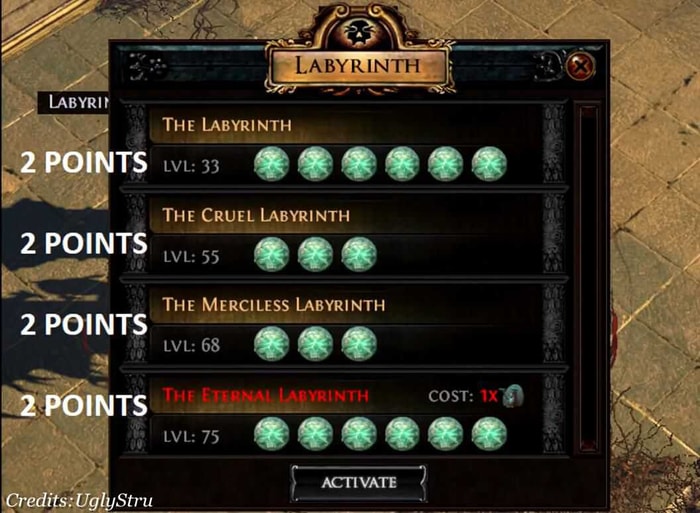
Vendor Recipes
As you journey on, you will encounter NPCs in town called Vendors. A majority of the items dropped by monsters probably have garbage stats or are not relative to your character in anyway, and can be sold to Vendors for currency shards.
The currency you get back can vary based on the item you’re selling or if you are using a vendor recipe. There are plenty of recipes that may be useful to you, but I’ll just go over some of the more important ones.
For example, if you vendor any item with at least 3 linked sockets of red, green, and blue, you will receive a Chromatic orb. If you vendor any item with at least 6 sockets, you will receive seven jeweler’s orbs in return.
Your loot filter will highlight items that are important for vendor recipes. So, just be sure to check the PoE Wiki for a full list.
Currency & Economics
The economy of Path of Exile is one of the most important systems in the game and is what really makes PoE differ from other RPGs. Its currency system doesn’t consist of gold and silver. Instead, the game uses a barter system and revolves around currency that is dropped by monsters.
Scrolls of Wisdom are the most common currency items that are used to identify a mod on magic, rare, and unique items dropped by monsters. You need to use Scroll of Wisdom on any item of any specific rarity in order to use it.
Portal Scrolls can be consumed to open a portal back to the closest town. Keep this in your inventory since it’s much quicker to do this than finding a waypoint.
Orbs of Transmutation turn a white item into a magic item with up to 2 mods. These are very common, and due to their accessibility, you will never really want to use white items.
Orbs of Augmentation allow you to add a random modifier on a magic item that only has 1 mod on it.
Orbs of Alteration randomly change the mods on magic items.
Blacksmith's Whetstone, Armourer's Scrap, Glassblower's Bauble, and Gemcutter's Prism will buff the quality of weapons, armor, flasks, and skill gems respectively. All quality does is buff the basic modifier on an item a little bit up to 20%. It’s not a huge deal but it’s good for min-maxing your build.
Jeweler’s Orbs randomly re-roll the number of sockets on an item. Re-rolling does not mean upgrade. The number of sockets will be chosen at random each time you use it. For example, if I use a Jeweler’s Orb on a five-socket item, it has the chance to turn it into a one-socket item. In general, the exact chances of obtaining a given number of sockets is unknown, but in the case of weapons the following is known:
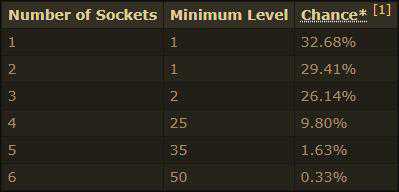
*These chances are specifically for weapons.
Orbs of Fusing randomly re-roll the socket links, and the colour and number of sockets remain unchanged.
Chromatic Orbs randomize the sockets’ color on your gear. There is an algorithm for color chances based on the item it’s used on. For example, if the item has energy shield and an intelligence requirement, it has a much higher chance to roll blue sockets rather than the green and red sockets. The same goes for armor and red sockets, and evasion for green sockets.
Orbs of Chance convert a white item to a different rarity at complete random from magic all the way up to unique.
Orbs of Scouring can be used on a magic or a rare item to convert it back to a white item with no mods at all.
Orbs of Regret are consumed to allow you to re-spec one of your points on your skill tree. These are really good if you want to completely re-spec your character, but they are pretty rare.
Orbs of Alchemy turn a white item into a rare item with up to 6 mods. These are much rarer than Orbs of Transmutation. However, just remember that they can only be used on white items, not magic items.
Regal Orbs allows you to turn a magic item into a rare item, and then adds another random modifier to it.
Chaos orb is the standard endgame currency for trading with other players. Chaos orbs re-roll modifiers on a rare item entirely, similar to the Orb of Alteration. I don’t recommend using them. Instead, I recommend you to hoard them and trade them to other players for the gear you may need.
Blessed Orbs are pretty useless. They just adjust the value of the base property of an item. For example, the Sapphire ring will give a Cold Resistance as their base property. A Blessed orb just re-rolls that value, leaving the other modifiers untouched. Once again, it’s good for min-maxing your builds, but otherwise completely useless.
What Vaal Orbs do is corrupt an item. Corrupting an item may add insane modifiers or completely change the item entirely. Its outcome is very unpredictable, and once the item is corrupted, it can’t be modified ever again. So, be very cautious when using these.
Divine Orbs, Exalted Orb, Mirror of Kalandra, etc. are very very rare and I don’t recommend using these. Just keep them in your stash until you really know what to do with them or just sell them to another player.
If you are really curious about the value of items, currency, or anything like that, poe.ninja is my favorite resource to track the economy and tell you the trade value of your currency.
Tips & Tricks
Lastly, I want to include some tips that help your character excel in the long run:
No. 1: Cap your resistances
New players often find themselves hitting walls and getting killed by almost everything at some point during the leveling process. Chances are A: your life pool is too low. B: you haven’t captured elemental resistances. C: both.
In your character window, you can view your current resistances here. Make sure you are always at 75% or else you will get completely obliterated by anything doing elemental damage. This is one of the most important modifiers to look for on your gear. Chaos resistance really isn’t as important, but it is cool to have if you can get it.
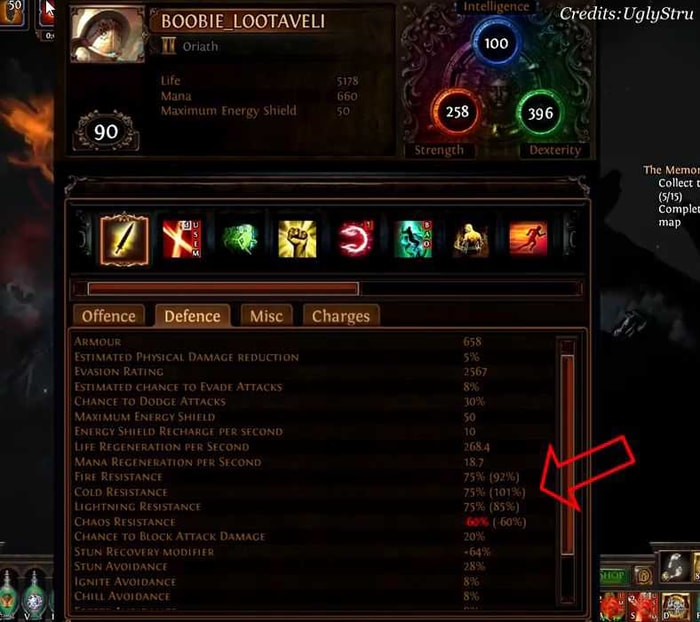
As you progress through the game, your resistances will get penalized, and it will take more than 75% of each on your gear to reach the effective resistance cap. For example, once you beat Act 10, you’ll get a 60% penalty to your resistance. So, at that point, your effective 75% resistance on your gear just really becomes 15%. This will be displayed in your character window. So, you will need to overcap your resistance to an effective 135% each.
Once your resistances are capped, maximum life on your gear becomes the most important value. I’d also recommend grabbing any increase to maximum life on the tree because this is how you will really fill out your life pool.
No. 2: Use vendor recipes
Be sure to use these. These are the easiest way to guarantee that you stay stocked up on Chromatic Orbs, Jeweler’s Orbs, Chaos Orbs, Orbs of Alchemy, and things like that.
No. 3: Kill faster
If you find yourself very poor, then you really need to kill stuff quicker, which is essentially the point of the game. Clear Speed is essential to maximizing your bank. The more you kill, the more stuff drops, the higher chance of getting better items.
Farming in certain areas with nice open layouts will probably be more efficient than others. So, just remember this when you are trying to save your money up for something nice.
No. 4: Follow a build guide
If you feel like your damage just isn’t high enough or you are not killing quickly enough, you may want to just follow a build guide from a more experienced player. Engineering Eternity, GhazzyTV, TarkeCat, and LiftingNerdBro are players that taught me pretty much everything I need to know about this game. Mathilification and ZiggyDTV are honorable mentions, but their tutorial and videos are a little more advanced, so I recommend checking them out once you have a better understanding of how the game works. They have plenty of in-depth guides on how to gear a character from start to finish.
The PoE forums also have many successful build guides for any and every skill you want to try out. Personally, I think the easiest build to learn the mechanics of the game with is a Cyclone duelist. It teaches the principles of balancing high raw physical damage output with survival on a pretty light budget. But you may just want to use something that’s fun to you.
No. 5: Trade trade trade
Some build guides you find may require specific unique items that you won’t really be able to farm yourself. The easiest thing to do is use a trading platform like poe.trade to buy the item from other players. It’s pretty simple to use when looking for unique items. Just search for the unique item name, check the price, click the whisper button to copy a request to your clipboard, and then paste it into the chat window. Someone will invite you to their party in which you will enter their hideout and then make the trade there. Trading can be very complex when looking for very specific mods or numeric values, but this should hopefully be enough to get you started. MmoGah is also a trustworthy site to buy PoE items.
I hope this guide can boost your confidence with this game at least get you prepared to jump into The Twilight Strand and start killing. You may encounter things that I didn’t touch on in this guide, but just do the best you can to search the wiki or the forums for a better understanding.
Please keep checking back for more news and guides related to PoE builds and PoE currency. MmoGah is a good place to buy PoE power leveling service which allows you to skip the grind and jump into your favorite part in the game.
YOU MAY ALSO LIKE:
PoE 3.9 Metamorph: Toxic Rain Build - Trickster Shadow
4 Ways to Turn Lower Tier PoE Currency into Exalts and Chaos Orbs



